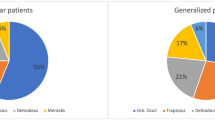Abstract
Neostigmine test (NT) is a pharmacological test, demonstrating a clinical improvement in patients affected by myasthenia gravis (MG). We aim to compare clinical evaluation and neurophysiological recordings by concentric-needle single-fiber electromyography (CN-SFEMG) in response to acute administration of neostigmine in ocular and generalized MG patients. Twenty-three MG patients (10 with ocular MG and 13 with generalized MG) were evaluated before and after 90 min neostigmine 0.5-mg administration. Clinical responsiveness was assessed by MG composite (MGC) scale. Neurophysiological evaluation by CN-SFEMG considered analysis of mean value of consecutive differences (MCD), single-pair jitter, and blocks. MGC scores significantly improved after NT in generalized MG patients (MGC 11.1 ± 7.6 vs 9.1 ± 6.7, p = 0.02), whereas the improvement was not significant in the ocular group. CN-SFEMG recordings significantly improved after NT in generalized MG patients (MCD 58.9 ± 18.8 vs 45.9 ± 23.2 μs, p = 0.003; single-pair jitter 49.8 ± 26.9 vs 24.1 ± 26.7%, p = 0.0001; blocks 6.2 ± 9.5 vs 2.6 ± 7.4%, p = 0.03) as well as in ocular MG patients (MCD 50.8 ± 22.7 vs 40.1 ± 22.9 μs, p = 0.01; single-pair jitter 35.9 ± 23.7 vs 20.0 ± 25.1%, p = 0.001). CN-SFEMG is a reliable tool to evaluate responsiveness to acute administration of neostigmine in MG. Moreover, neurophysiological modifications to NT could show subclinical improvement in ocular MG better than that of the clinical scale.

Similar content being viewed by others
References
Gilhus NE, Verschuuren JJ (2015) Myasthenia gravis: subgroup classification and therapeutic strategies. Lancet Neurol 14(10):1023–1036. https://doi.org/10.1016/S1474-4422(15)00145-3
Benatar M, Hammad M, Doss-Riney H (2006) Concentric-needle single-fiber electromyography for the diagnosis of myasthenia gravis. Muscle Nerve 20(34):163–168
Benatar M (2006) A systematic review of diagnostic studies in myasthenia gravis. Neuromuscul Disord 16(7):459–467. https://doi.org/10.1016/j.nmd.2006.05.006
Witoonpanich R, Dejthevaporn C, Sriphrapradang A, Pulkes T (2011) Electrophysiological and immunological study in myasthenia gravis: diagnostic sensitivity and correlation. Clin Neurophysiol 122(9):1873–1877. https://doi.org/10.1016/j.clinph.2011.02.026
Stalberg E, Sanders DB (2009) Jitter recordings with concentric needle electrodes. Muscle Nerve 40(3):331–339. https://doi.org/10.1002/mus.21424
Vincent A, Palace J, Hilton-Jones D (2001) Myasthenia gravis. Lancet 357(9274):2122–2128. https://doi.org/10.1016/S0140-6736(00)05186-2
Sarrigiannis PG, Kennett RP, Read S, Farrugia ME (2006) Single-fiber EMG with a concentric needle electrode: validation in myasthenia gravis. Muscle Nerve 33(1):61–65. https://doi.org/10.1002/mus.20435
Meriggioli MN, Sanders DB (2004) Myasthenia gravis: diagnosis. Semin Neurol 24(01):31–39. https://doi.org/10.1055/s-2004-829594
Burns TM, Conaway M, Sanders DB, on behalf of the MG-QOL15 study group (2010) The MG composite. A valid and reliable outcome measure for myasthenia gravis. Neurology 74(18):1434–1440. https://doi.org/10.1212/WNL.0b013e3181dc1b1e
Kimura J (2001) Myasthenia gravis and other disorders of neuromuscular transmission. In: Kimura J (ed) Electrodiagnosis in diseases of nerve and muscle: principles and practice, 3rd edn. Oxford University Press, New York, pp 753–777
Ing EB, Ing SY, Ing T, Ramocki JA (2000) The complication rate of edrophonium testing for suspected myasthenia gravis. Can J Ophthalmol 35(3):141–144. https://doi.org/10.1016/S0008-4182(00)80007-1
Engel AG (1994) Myasthenic syndromes. In: Engel AG, Franzini Armstrong C (eds) Myology. McGraw Hill, New York, pp 1798–1835
Stålberg E (2012) Jitter analysis with concentric needle electrodes. Ann N Y Acad Sci 1274(1):77–85. https://doi.org/10.1111/j.1749-6632.2012.06775.x
Evoli A, Iorio R, Bartoccioni E (2016) Overcoming challenges in the diagnosis and treatment of myasthenia gravis. Expert Rev Clin Immunol 12(2):157–168. https://doi.org/10.1586/1744666X.2016.1110487
Zambelis T, Pappas V, Kokotis P, Zouvelou V, Karandreas N (2015) Patients with ocular symptoms referred for electrodiagnosis: how many of them suffer from myasthenia gravis? Acta Neurol Belg 115(4):671–674. https://doi.org/10.1007/s13760-015-0460-x
Massey JM, Sanders DB, Howard JF (1989) The effect of cholinesterase inhibitors on SFEMG in myasthenia gravis. Muscle Nerve 12(2):154–155. https://doi.org/10.1002/mus.880120211
Viets HR, Schwab RS (1955–1956). Problems in the diagnosis of myasthenia gravis; a 20-year report of the neostigmine test. Trans Am Neurol Assoc (80th Meeting):36–41
Valls-Canals J, Montero J, Pradas J (2000) Stimulated single fiber EMG of the frontalis muscle in the diagnosis of ocular myasthenia. Muscle Nerve 23(5):779–783. https://doi.org/10.1002/(SICI)1097-4598(200005)23:5<779::AID-MUS16>3.0.CO;2-Z
Shin HY, Park HJ, Lee HE, Choi YC, Kim SM (2014) Clinical and electrophysiologic responses to acetylcholinesterase inhibitors in MuSK-antibody-positive myasthenia gravis: evidence for cholinergic neuromuscular hyperactivity. J Clin Neurol 10(2):119–124. https://doi.org/10.3988/jcn.2014.10.2.119
Farrugia ME, Weir AI, Cleary M, Cooper S, Metcalfe R, Mallik A (2009) Concentric and single fiber needle electrodes yield comparable jitter results in myasthenia gravis. Muscle Nerve 39(5):579–578. https://doi.org/10.1002/mus.21151
Author information
Authors and Affiliations
Corresponding author
Ethics declarations
The study was approved by the Local Ethic Committee and patients were enrolled only after they signed the written informed consent.
Conflict of interest
The authors declare that they have no conflict of interest.
Rights and permissions
About this article
Cite this article
Sciacca, G., Reggio, E., Mostile, G. et al. Clinical and CN-SFEMG evaluation of neostigmine test in myasthenia gravis. Neurol Sci 39, 341–345 (2018). https://doi.org/10.1007/s10072-017-3194-0
Received:
Accepted:
Published:
Issue Date:
DOI: https://doi.org/10.1007/s10072-017-3194-0




